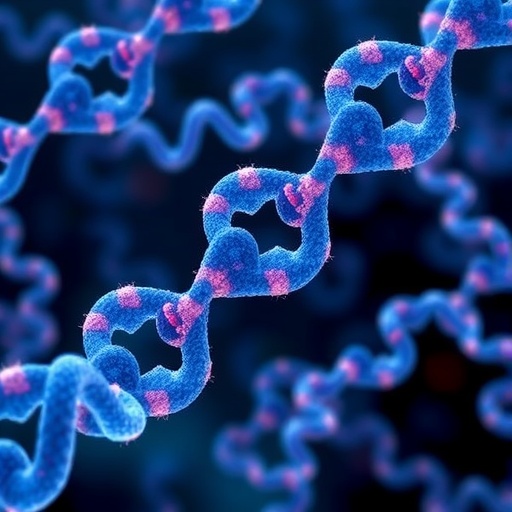In the race to unravel the intricate genetic underpinnings of human disease, scientists have long relied on two predominant methodologies: genome-wide association studies (GWAS) and burden tests. Each approach has illuminated different facets of biology, but until recently, the disparity in their findings remained a confounding puzzle. A groundbreaking study published in Nature on November 5, 2025, provides compelling insights into why these methods highlight distinct gene sets and how this knowledge could revolutionize drug discovery.
The human genome is a vast expanse of genetic information, comprising not only thousands of genes encoding proteins but also vast stretches of regulatory DNA that dictate when and where genes are expressed. Tiny variations in this code, known as genetic variants, can influence a spectrum of traits, from height and hair color to susceptibility to complex diseases. GWAS typically survey common variants dispersed across both genes and regulatory sequences to link genetic differences with diseases. In contrast, burden tests focus narrowly on rare, often deleterious variants that disrupt protein function, offering a different lens into disease biology.
Leveraging data from the UK Biobank—a colossal repository containing genetic and health information from hundreds of thousands of individuals—researchers from NYU Langone Health, Stanford, UC San Francisco, and the University of Tokyo embarked on a comprehensive analysis of 209 traits. Their meticulous comparison revealed a stark dichotomy: burden tests predominantly identify genes whose disruption impacts a specific disease with minimal influence on other traits. Meanwhile, GWAS unearth genes that not only associate with particular diseases but also exhibit pleiotropic effects, influencing multiple diseases and biological processes simultaneously.
This divergence, the researchers explain, stems from fundamental evolutionary dynamics and gene function. Genes differ in their trait specificity—some are specialist genes affecting a singular biological trait, while others are generalists with roles across diverse physiological systems. Variants that severely impair these pleiotropic genes tend to have widespread detrimental consequences, reducing survival or reproductive success. Such variants are rare in the population due to strong negative selection and thus elude detection by burden tests, which require rare variant enrichment. Conversely, GWAS can detect regulatory variants in these genes since regulatory changes often modulate gene expression more subtly and escape purifying selection.
A paradigm-shifting revelation from this study concerns the traditional statistical metric—the p-value—commonly used to gauge the reliability of genetic association results. Surprisingly, p-values from both GWAS and burden tests poorly correlate with a gene’s true biological “importance,” defined here as the gene’s causal impact on disease phenotype when disrupted. This finding challenges the prevailing assumption that the most statistically significant genes necessarily hold the greatest biological relevance, urging scientists to refine gene prioritization strategies beyond conventional metrics.
Dr. Hakhamanesh Mostafavi from NYU Langone Health, co-senior author of the study, highlighted the significance of this insight: “Our work clarifies why GWAS and burden tests yield different conclusions and underscores the need for novel interpretive frameworks. Understanding gene importance and trait specificity concurrently is crucial for pinpointing therapeutic targets accurately and anticipating off-target drug effects.”
The researchers advocate for a nuanced dual-parameter model of gene prioritization, incorporating both importance and specificity. Importance quantifies how much a gene influences disease risk upon disruption, while specificity gauges whether a gene primarily affects one trait or multiple traits. Mapping genes onto this two-dimensional landscape could streamline the identification of high-value drug targets—genes with strong disease impact and high specificity—thereby maximizing therapeutic efficacy while minimizing systemic side effects.
Recognizing the limitations of GWAS and burden tests in isolation, the team is pioneering integrative computational methods that harness the power of burgeoning experimental datasets. These datasets capture functional genomics data at the cellular level, detailing gene expression patterns, protein interactions, and regulatory networks with exquisite resolution. By combining genetic association signals with such multi-omics information through machine learning algorithms, the researchers aim to infer gene importance more robustly and accurately.
According to co-senior author Dr. Jeffrey Spence of UCSF, “This integrative approach represents a potential paradigm shift. It allows us to translate vast amounts of cellular-scale data into actionable insights for human disease traits. Enhanced gene prioritization will accelerate drug discovery by focusing on the most biologically impactful candidates.”
The implications of this research extend beyond disease gene identification. By understanding the fundamental genetic architecture that differentiates specialists and pleiotropics within the genome, scientists can better appreciate how natural selection shapes disease susceptibility. The study also underscores the evolutionary constraints limiting the detectability of certain pathogenic variants and offers a conceptual framework for interpreting genetic pleiotropy in complex traits.
Importantly, the findings urge caution in the overinterpretation of GWAS results, which often implicate numerous genes per disease, complicating downstream biological validation. Burden tests, while more conservative, may miss critical pleiotropic genes with large systemic effects. A balanced, integrative methodology promises a clearer picture of disease mechanisms and a strategic approach to therapeutic intervention.
This comprehensive analysis harnesses an unprecedented scale of genetic data and collaboration among leading research institutions globally, including NYU Langone Health, Stanford University, UC San Francisco, the University of Tokyo, the University of Chicago, and Columbia University. Their work, supported by National Institutes of Health funding, sets the stage for transforming the landscape of precision medicine.
As the volume and granularity of genetic and functional data continue to expand, the synergy of computational modeling and deep biological understanding will become indispensable. By transcending the limitations of current gene-ranking paradigms, the scientific community moves closer to deciphering the complex interplay between genotype and phenotype, ultimately paving the way for innovative treatments tailored to individual genetic landscapes.
Subject of Research: People
Article Title: ‘Specificity, length and luck drive gene rankings in association studies
News Publication Date: 5-Nov-2025
Web References: http://dx.doi.org/10.1038/s41586-025-09703-7
Keywords: Genome wide association studies, Gene identification




